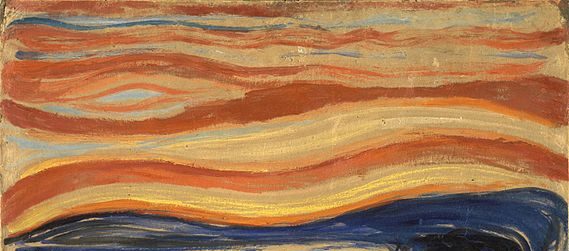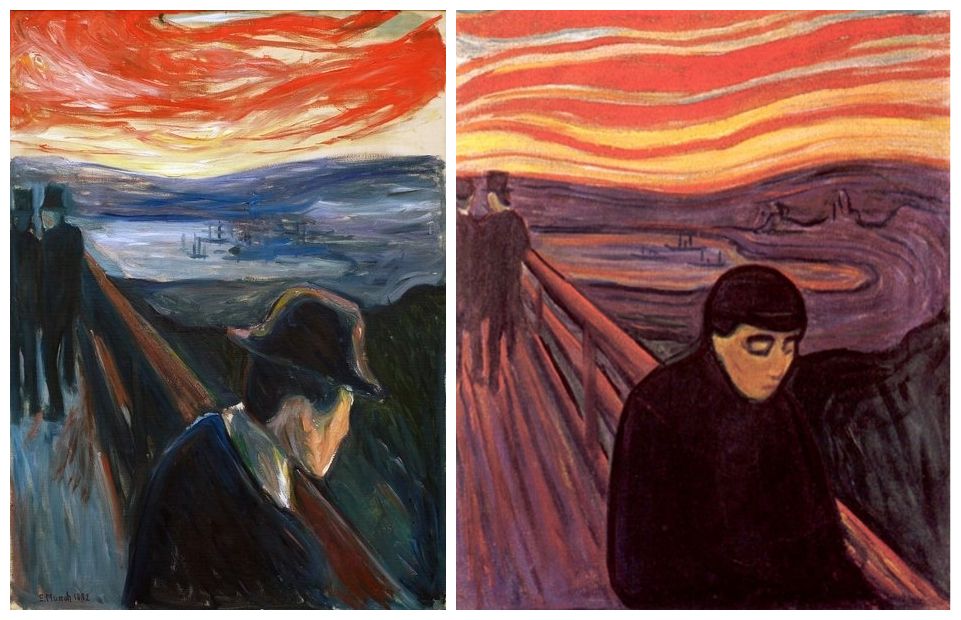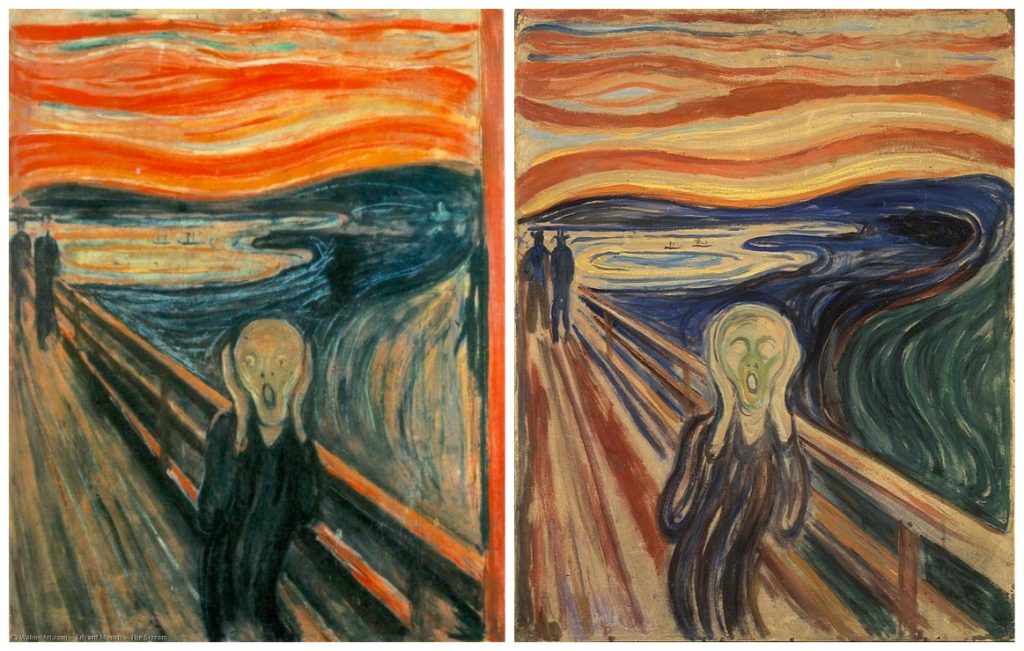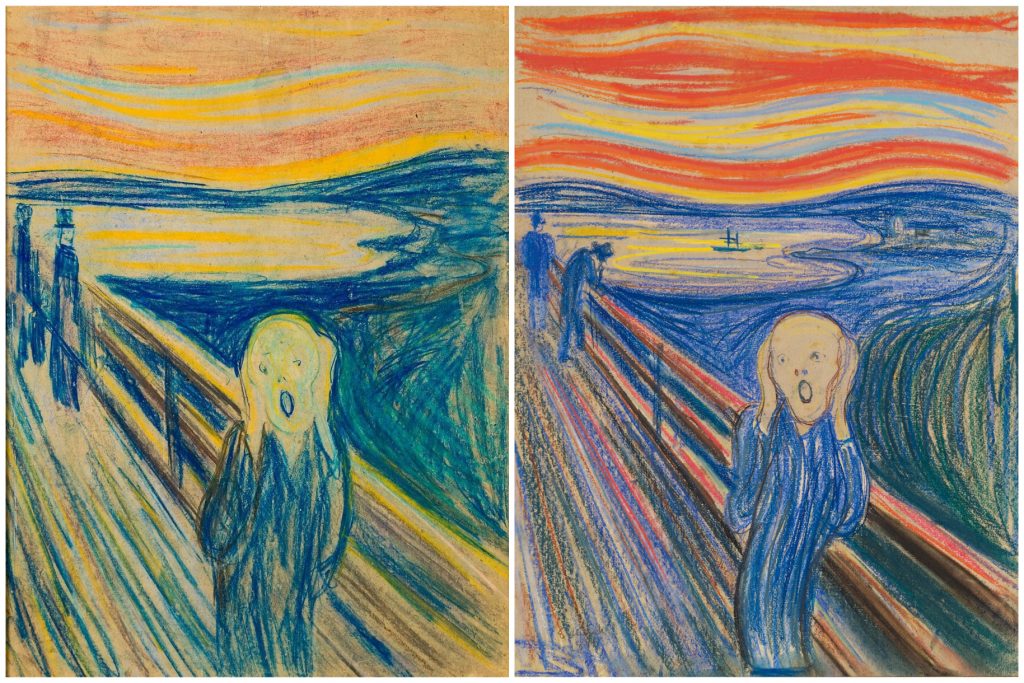Edvard Munch was walking along a road with his friends. He felt tired and sick. Munch stopped. The sun was setting. Suddenly, he noticed that the sky turned blood red. “I sensed an infinite scream passing through nature,” the artist later recalled.
He depicted that scream many times – with oils, pastel, and other media.
Oil Paintings on Canvas
Strictly speaking, Munch’s oil works based on his impression of the flaming clouds are not titled The Scream; their title is Despair. Nevertheless, they can be considered close relatives of the iconic masterpiece, as all these works have very similar compositions.
A man is standing at the railing, while two others are going away. In the background, tongues of sunset fire are wriggling above a blue-black fjord and a bay.
The straight railing rushing towards the horizon provides an effect of depth; the turbulent lines of the landscape set the space in motion. Thanks to the felicitous perspective, the paintings seem to draw us into themselves.
This site really exists. Scholars identify it as a road on Ekeberg Hill near Kristiania (present-day Oslo). The road once led to a house where the artist lived for a while.
Both paintings are relatively lifelike. We can even guess who the central characters of the artworks are. The gentleman wearing a bowler may be Edvard Munch; the youth in the work, painted in 1894 has something in common with Munch’s friend Jappe Nilsen. It was in the early 1890s when Nilsen experienced an unhappy love for a bohemian femme fatale.
Tempera on Cardboard
On the left, you see the famous The Scream that inspires social media users to continually make new memes. It’s often considered to be an oil painting, yet in fact, it was created with tempera, oils, and pastel.
The work on the right is painted with one medium – tempera.
Instead of a realistic character as before, the artist here portrayed a mysterious distorted figure in a black garment. The strange сreature has its mouth wide open – perhaps it’s crying. However, it also hears a shrill sound: the creature covers its ears. The scream from the title is primarily the explosion of the intense colors representing the sky, the ground, and the water. Something horrific is about to happen to the world soon.
The work from 1893 is notable for the pencil text in a corner that reads, “could only have been painted by a madman”. This insulting inscription is fully identical to… Edvard Munch’s handwriting. When The Scream was exhibited in Kristiania, it provoked furious criticism and public speculation on the artist’s mental state. Apparently, he left this bitter sentence on his own painting as an ironic response to his detractors. There was a little grain of truth in their words: Munch had quite fragile mental health. He wrote in his diary:
For as long as I can remember I have suffered from a deep feeling of anxiety which I have tried to express in my art.
Around 1900, he started to drown his troubles in strong drinks and became addicted to alcohol. His alcoholism catalyzed the manifestation of additional psychological disorders; in particular, persecution mania.
Paper Drawings with Pastel
In pastel, Munch’s motif of the infinite scream is represented at least twice. The first drawing probably was simply a preliminary study. Its tones are faint; the strokes are messy. The artist drew neither the tiny ships nor the contours of city buildings.
The second pastel, far more elaborated than the first, is as a completed, independent work. It features a very interesting detail. Do you see the man in a hat? He’s leaning on the railing with his head bowed. The man’s pose expresses extreme fatigue, perhaps dismay but certainly not calm indifference. The central character isn’t the only being who has to suffer.
I’d love to own this drawing… but of course, I’ll never be able to afford it. The 1895 pastel version of Munch’s The Scream is one of the most expensive pieces of art in the world. A few years ago, a private collector bought it for nearly US $120 million at Sotheby’s.
Lithographic Prints
What makes Munch’s Despair and the legendary The Scream created in 1893 and the best pastel version of the masterwork so powerful is their vibrant colors. We could assume that The Scream wouldn’t “sound” persuasive in black and white… and would be wrong.
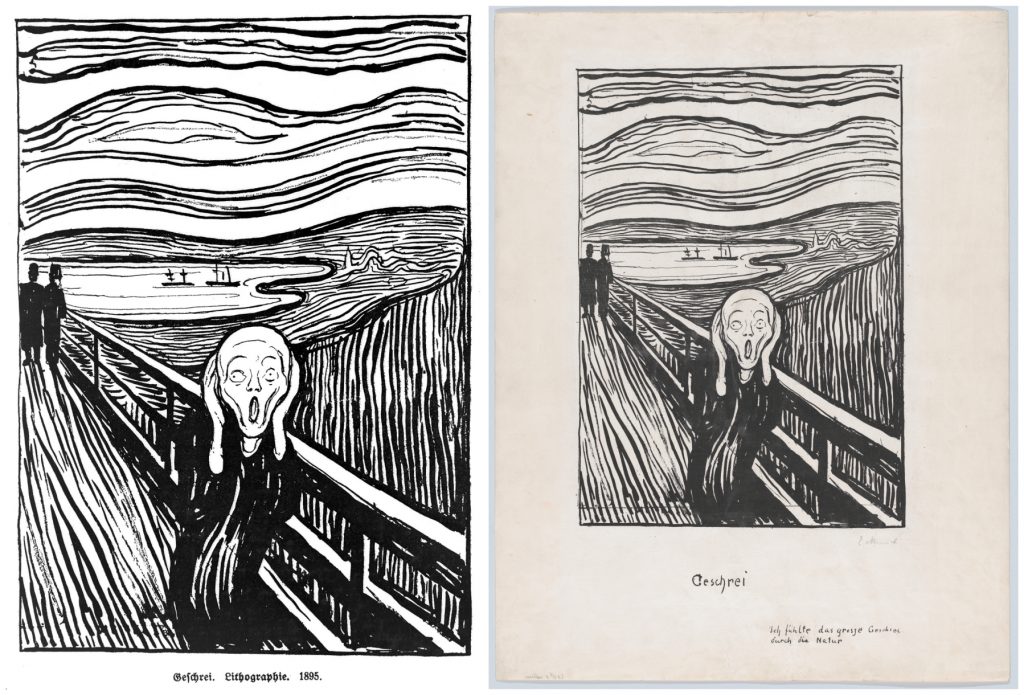
With strong lines, the artist brilliantly conveyed everything that he previously emphasized with color.
In a sense, the graphical work is more frightening than the painted ones. The sharply-outlined white head of the main figure looks like a skull.
The reproductions above are prints from the same lithograph stone. Approximately 50 examples of such a print were produced before the original stone was resurfaced.
Ink Work
The last picture I want to share with you today is especially mysterious. This ink drawing is unnamed but the face of the strange creature depicted in it seems familiar, right?
In the other works, nature screamed. In the unnamed drawing, the scream is solely human. Instead of the blazing sky, the artist drew outstretched arms with hands resembling spurts of flame.
The work reminds us of the Second World War, although Munch did not live to see the time when mankind truly realized its horrors – he died in January 1944.
…So, here are eight interpretations of one motif. Why did Edvard Munch rethink it over and over again? The artist knew: every sketch, let alone a painting, is completely unique. It can be a great surprise even for its creator.
- Эдвард Мунк. Биография художника [Edvard Munch. A Biography of the artist] – Атле Нэсс, КоЛибри, 2021
- Edvard Munch. Life Expressions – Nikita Mathias, Munchmuseet, 2020
- The Mysterious Road From Edvard Munch’s “The Scream” – Zuzanna Stanska, Daily Art Magazine, 12 December 2016
